|
Special Features





Image Libraries


|
|
Blog
“Urban rooms” are outdoor spaces that are framed by surrounding buildings, with the effect of a partial sense of enclosure. Most of the best public spaces in the world are urban rooms. Dupont Circle is one, the National Mall is another. Most public squares qualify. Even segments of street can qualify, if they feel enclosed enough.
One interesting thing that Europeans sometimes do to improve their urban rooms is give them a top, using strings of lights. One wouldn’t want to put a complete roof over an urban room because the whole point is that they are outside, but a partial cap that tops the space while leaving it primarily open-air can be a beautiful addition. It’s the sort of thing that can help define a public place as particularly special.
Here are two examples from Europe. Imagine something similar over 7th Street in Gallery Place or running along K Street downtown.
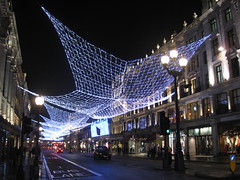
London’s Regent Street.
Photo by ejbaurdo. |

Vienna’s Graben street.
Photo by MorBCN. |
Average Rating: 4.9 out of 5 based on 197 user reviews.
November 29th, 2011 | Permalink
Tags: galleries, urbandesign

Five years after the great mortgage collapse ruined outer suburbia, Americans are starting to believe that it isn’t coming back. Demographic and cultural changes have resulted in a permanent oversupply of suburbia.
That’s the basic premise behind an interesting New York Times op/ed by Chris Leinberger titled The Death of the Fringe Suburb. Leinberger claims that we are now in the midst of a reversal of the 1950s suburban explosion, and that the demographic convergence of millenials entering adulthood and baby boom empty-nesters ensures that the reversal is no mere blip.
Leinberger is right, but he fails to mention that what is happening is bigger than a simple reversal of trends. It’s the failure of an experiment, and the return to traditional methods of city building.
Most Americans think of suburbia as normal, but in reality it is anything but. American suburbia was a 50 year experiment. After World War II we made a massive investment in a new way of living. We abandoned thousands of years worth of urbanist heritage in order to build our lives around cars. It seemed like a good idea at the time. Now, a half century later, we’ve learned that our new paradigm has problems of its own. Large numbers of us now believe that the old way is better.
Never again will Americans think of suburbia as the problem-free utopia that our grandparents imagined it to be. The results from our experiment are in, and they are mixed at best.
My point is this: American suburbia was an historical blip, and our return to urbanism is nothing but a return to normalcy. We’ve always had suburbs and we always will have suburbs, but their day in the sun as the dominant paradigm of city building is coming to an end.
Average Rating: 4.5 out of 5 based on 221 user reviews.
November 28th, 2011 | Permalink
Tags: history, social

Good for Metro, for covering this previously blank wall at Farragut West station with a little bit of color. Little projects like this are easy, inexpensive, and make the city a more vibrant and interesting place.
Ornament is a good thing. Let’s have more of it.

Forgive the cell phone picture.
Average Rating: 5 out of 5 based on 249 user reviews.
November 23rd, 2011 | Permalink
Tags: architecture, metrorail, transportation, urbandesign

The major remaining segment of the InterCounty Connector opens today in Maryland, connecting Gaithersburg to Laurel via highway. The first segment opened in February, but the complete I-270 to I-95 trip wasn’t yet possible until today.
The event marks a good occasion to consider the long debated outer beltway, and whether it really died in the 1980s when it was officially rejected.
Attached is a map showing major roads in the DC region, with regional highways that serve the same function as as outer beltway highlighted. Light red roads are true Interstate-quality highways, while dark red roads may have occasional traffic lights in place of much more expensive interchanges. Both are regional expressways, with infrequent crossings and no (or extremely few) directly fronting buildings.
As you can see, there are not many gaps remaining in the loop. The idea of an outer beltway as an official unified regional facility may have died decades ago, but it is clearly living on, and being advanced, in the form of local projects in each jurisdiction.
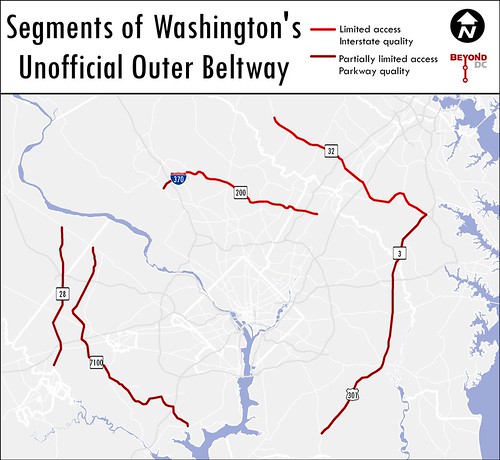
Click the map for a larger version.
Average Rating: 4.5 out of 5 based on 263 user reviews.
November 22nd, 2011 | Permalink
Tags: roads/cars, transportation

This is a partial scan of a 1978 Metrobus map produced by Arlington County. A couple of interesting things that jump out to me are the fare zone boundaries running along the left side of the page and through Arlington Cemetery, and several routes that no longer exist, such as route 10 running along Fairfax Drive in “Parkington” (now Ballston).
What do you see that’s interesting?
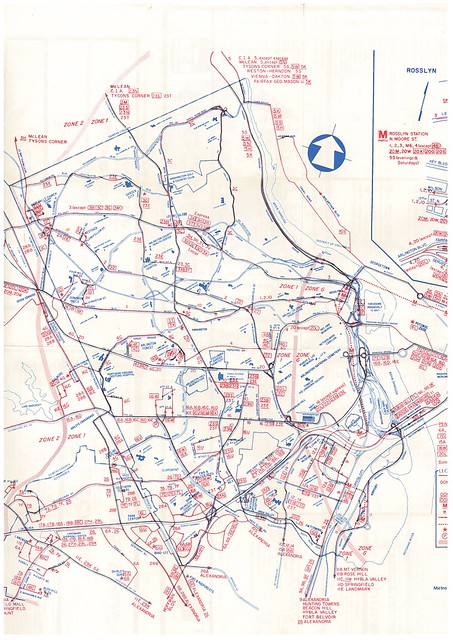
Somewhat larger version.
Much larger version.
Average Rating: 5 out of 5 based on 216 user reviews.
November 21st, 2011 | Permalink
Tags: bus, galleries, history, transportation

Toronto has, by a large margin, the most comprehensive streetcar network in North America. There are currently 11 lines operating on 47 miles of track, which together attract over 300, 000 daily riders.
That’s more riders than any light rail system in the US, including those that are fully separated from cars. It’s more riders than any US commuter rail system outside of New York or Chicago. It’s in the same league as the Philadelphia and Boston subways. It is, put simply, a huge number.
So when Toronto gets new streetcars, the rest of North America pays attention.
The whole continent pays attention because Toronto’s plans affect the price of streetcar vehicles everywhere. Transit agencies often bundle vehicle orders together with orders from other agencies, in order to get a bulk rate. It’s a simple idea: If you order more vehicles, you get a lower price. Therefore if multiple transit agencies want to order the same vehicle at the same time, they often do so together and pay less. This is exactly why DC ordered some of its streetcar vehicles years before the first line was ready to open. Portland was ordering streetcars for their system, so DC bundled its order with theirs to save money.
Economies of scale are at work. The more other cities use the same streetcar vehicle as you, the more you can save money. Not just on vehicle orders, but on more standardized parts, maintenance, etc.
Here is what Toronto will be using. It’s produced by Bombardier, and is called the “Flexity Outlook” model. The photo is from Torontoist, which has a post with several more.

By the way, Toronto’s per capita transit ridership blows ours out of the water. Their mixed-traffic streetcars are big part of the reason why, although it wouldn’t be fair to say they’re the only reason.
Average Rating: 5 out of 5 based on 237 user reviews.
November 18th, 2011 | Permalink
Tags: streetcar, transportation

Take a look at this picture of Key Bridge, taken in 1965. Rosslyn is in the foreground, with Georgetown across the river. That circle, which was called Rosslyn Circle, is not there anymore. Zoom in to the full-size image and you can clearly see an old bus terminal. According to the photo description, the terminal is where DC Transit buses turned around. Much like DC Circulator today, the old DC Transit bus system included a route that crossed into Rosslyn. Photo by Roger Wollstadt.
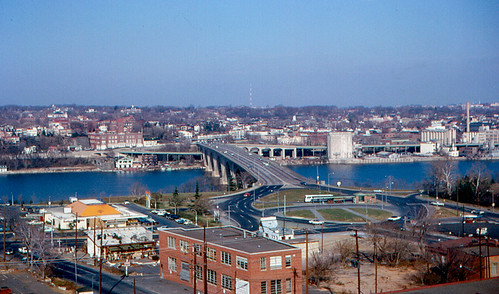
Average Rating: 4.8 out of 5 based on 253 user reviews.
November 16th, 2011 | Permalink
Tags: bus, fun, galleries, history, roads/cars, transportation

|
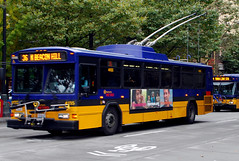
Trolleybus in Seattle. |
Trolleybuses are rubber-wheeled buses that are powered by overhead wires. They offer a number of advantages over regular buses, but are very rare in the United States.
There are currently only five US cities that operate trolleybuses. They are Boston, Philadelphia, San Francisco, Seattle, and Dayton. Trolleybuses are so rare because they require overhead wires, which are expensive to install, limit bus route flexibility, and are often considered ugly.
On the other hand, compared to normal diesel buses, trolleybuses are quieter, smoother, cleaner, and accelerate faster. They also offer a sense of permanence that normal buses can’t match.
Many of the advantages of trolleybuses come from their power source. Since they run on electricity rather than fossil fuels they emit no fumes, and they accelerate quickly, smoothly, and quietly. However, all those advantages can be duplicated by wire-free electric buses without the cost or trouble of overhead wires.
So why bother with wires?
Because the cost and relative rarity of wires is a sure signal that a transit route will be predictable and permanent. Wires provide the same sort of visual fortification that rail tracks provide. They are a clear signal to riders that they are dealing with a significant and special transit line.
Since so few trolleybuses have been built in recent years, and all the cities that use them have used them for decades, it is difficult to know how much of an effect wires without tracks can have on transit oriented development. Given the push for affordable BRT in many cities, the potential prospect of TOD-inducing buses is something that ought to be explored.
|

Trolleybuses can shift lanes without disconnecting their wires. |
Trolleybuses even offer a significant advantage over rail streetcars. Since they aren’t tied to tracks, flexible trolley poles allow buses to switch lanes in order to go around obstructions. Without tracks to constrain them, trolleybuses mixing in a lane with cars are less likely to be held up by traffic. Additionally, many trolleybuses are built as hybrids and are capable of lowering their poles and running on batteries or fossil fuels as a backup.
It is unfortunate that the so few trolleybus systems survived the 20th Century. Most of them fell victim to the same transit death spiral that destroyed most American streetcar systems.
However, streetcars are enjoying a renaissance because contemporary planners have discovered they can be useful. It may be time for trolleybuses to enjoy a renaissance of their own.
Average Rating: 5 out of 5 based on 176 user reviews.
November 14th, 2011 | Permalink
Tags: bus, transportation

The first of Arlington’s new batch of Capital Bikeshare stations was installed this morning in Courthouse, and is now up and running. According to Arlington, another station will be installed tomorrow in Clarendon, and another four in that area will go in later this month.
The new bikes come with a couple of upgrades. The basket is a little bit more sturdy, and a new set of “standing lights” will continue to flash for 90 seconds after these bikes stop moving. The new lights are a big safety upgrade. Lights on older bikes stopped flashing whenever a bike stopped moving, which meant bikes stopped at red lights weren’t lit up.
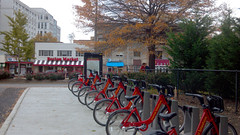
New Cabi station in Courthouse. |
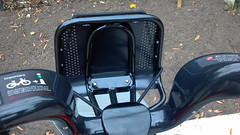
New basket. |
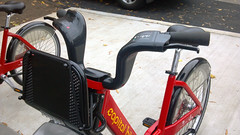
Note the new set of lights on the bottom of the basket frame. |
Average Rating: 4.7 out of 5 based on 241 user reviews.
November 10th, 2011 | Permalink
Tags: bike, galleries, transportation

|

Bcycle bikes in Boulder.
Photo by Mr. T in DC. |
Baltimore is planning to launch its bikesharing system next summer, and is moving forward ironing out the details.
According to The Bike-sharing Blog, Baltimore is shooting for a 30-station, 250-bike system focused around downtown and Fells Point. They are planning on calling the system Charm City Bikeshare, to complement the branding of the Charm City Circulator bus system.
Earlier today the city announced that they have officially selected Bcycle to build and operate the system. Bcycle operates Denver’s extensive bikesharing network, as well as smaller networks in nine other US cities. They are the primary US competitor to Bixi, which operates four networks in the US, including Capital Bikeshare.
It’s unfortunate that Baltimore and DC will be using different systems, and therefore won’t be able to cross-honor memberships. Nonetheless, bikesharing has proven to be an effective and affordable form of urban transportation, so it’s exciting to see more and more cities taking it up.
Average Rating: 4.6 out of 5 based on 224 user reviews.
November 9th, 2011 | Permalink
Tags: bike, transportation

|
Media





Site
About BeyondDC
Archive 2003-06
Contact
Category Tags:
Partners
|


























